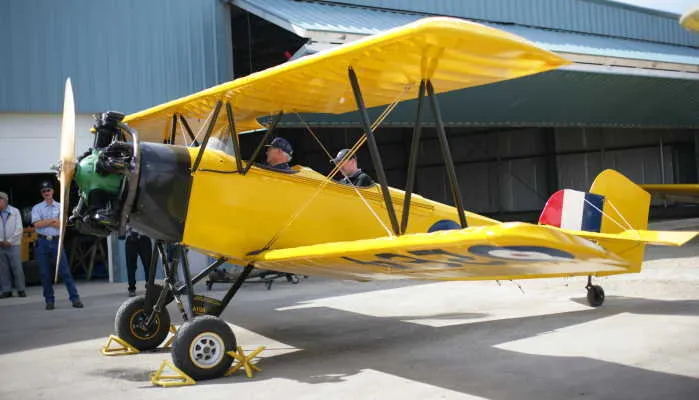Fleet Fawn

(Source Bomber Command Museum of Canada)
The Fleet Fawn first saw service with the Royal Canadian Air Force in 1931 when twenty Mk I's were delivered. Several versions of the "Fawn" design were manufactured during the 1930's, with the first Mk II (7c)'s being delivered to the RCAF in 1936. This version featured a 140 hp Armstrong Siddeley Civet seven cylinder radial engine and was soon found to be the best of the Mk II's.
A total of 71 Fawn Mk II's were built between 1931 and 1938 at the Fleet Aircraft of Canada's plant at Fort Erie, Ontario. As a two-seater primary trainer they were felt to have excellent flying characteristics together with a rugged strength which inspired confidence. The RCAF was very impressed with the Fleet Fawn and claimed that the aircraft was one of the factors which improved its flying standards during the 1930's.
The aircraft consists of a fabric-covered welded-steel fuselage with metal panels forward of the wooden cockpits. It has steel-tube fairing formers and wooden stringers. The wings are of equal spans, single bay, and wire braced. The upper wing was made in one piece and constructed with two solid spruce spars. Ailerons are found only on the bottom wings. Stamped aluminium alloy ribs were used to construct the wings and steel-tube compression struts are at the interplane and centre section of the wings. Interlaced between the wings are streamlined landing and flying wires. During the late 1930's a sliding cockpit enclosure became standard equipment of all RCAF Fawns.
Forty three Fleet Fawn trainers were operational with the Royal Canadian Air Force when war was declared in 1939. They were used primarily to train hundreds of flight instructors under the British Commonwealth Air Training Plan during the war. The Fawn remained in service with the RCAF until 1947. Bomber Command Museum of Canada
 Bomber Command Museum of Canada
Bomber Command Museum of Canada
CASPIR Aircraft Groups:
RCAF On Strength (51), RCAF 400 Squadron (1), Canadian Aircraft Losses (3)Fawn II 219
With “A” Flt of FTS as of 16 Apr 1936. To Trenton as of 21 Jun 1937. To Fleet Aircraft in Fort Erie for overhaul on 25 Nov 1938 with 703:30 flying hours at a cost of $3,035.38. Back to Camp Borden as of 20 May 1939. Category "A" damage near Cookstown, ON while at Camp Borden, ON with “A” Flight of the Intermediate Training Squadron (ITS) 24 July 1939. Pilot Officer (Provisional) E.E.F. Devlin was killed. The aircraft was on a formation flying mission and the official cause of the accident was listed as “obscure” but the a/c crashed into trees during the practice.
1936-03-31 Taken on Strength 2019-08-20
1940-03-11 Struck off Strength Cat “A” write-off; some components salvaged 2022-01-04




 Library and Archives Canada Service Files (may not exist)
Library and Archives Canada Service Files (may not exist) Fleet Fawn
Fleet Fawn Wikipedia Fawn
Wikipedia Fawn Fawn - Kestrel Publications
Fawn - Kestrel Publications